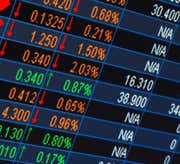
|
Japan established the earliest recognized futures trading exchange in 1710 as a way to trade rice futures. More than a century later, in 1848, the Chicago Board of Trade (CBOT) formed, becoming the first official commodity trading exchange in the west. The first traded futures contract in the U.S. was corn, followed by wheat and soybeans. Several years later, the first forward contracts in cotton began trading in New York, and other contracts, including cocoa, orange juice, sugar, cattle and pork futures, soon followed. By the 1970s, the Chicago Mercantile Exchange (CME) started offering futures trading in foreign currencies and the New York Mercantile Exchange (NYMEX) began offering various financial futures, including U.S. Treasury bonds and stock index futures.
Originally, the futures markets were designed to connect real producers and end-users of raw commodities. Central grain markets were established, and a central marketplace was created for farmers to bring their commodities and sell them either for immediate delivery (spot trading) or for forward delivery. These forward contracts helped protect farmers against the loss of crops and profits and stabilize supply and prices in the off-season.
Today's futures market is a global, electronic marketplace for not only agricultural goods, but also for currencies, metals, energy and financial instruments such as Treasury bonds and stock index futures. While producers and end-users still use the futures markets, all types of investors and traders access the commodity and financial futures markets to hedge and speculate – and try to make a profit. (For related reading, see What is the Difference Between Hedging and Speculation?)
There are futures trading exchanges around the world, but the U.S. exchanges remain the most widely traded, due in large part to the popularity and liquidity of the U.S. 10-year T-note, crude oil, e-mini S&P 500 stock index future and gold contracts. (For more, see What is the History of Futures?)
Futures Fundamentals: How The Market Works
-
 Investing
InvestingCurrency Futures: An Introduction
Find out why forex market is not the only way for investors and traders to participate in foreign exchange. -
 Trading
TradingAdvantages Of Trading Futures Over Stocks (APPL)
We look at the top eight advantages of trading futures over stocks. -
 Investing
InvestingAll About Liquid Commodities
You might hear 'liquid commodities' and think of an auction, but they're actually a high-volume, fast paced financial product suitable for day traders. -
 Investing
InvestingTrading The Soft Commodity Markets
Learn the contract specifications for a few of the most heavily traded commodities.


